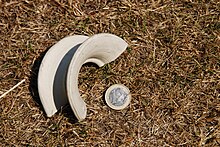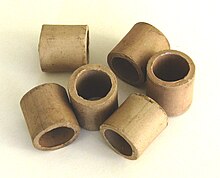Packing
Packing bodies are unstructured internals in apparatus in process engineering and in apparatus construction.
In chemical processes, mostly in two-phase mixtures, they are used to enlarge the surface of action by turbulence while at the same time reducing flow resistance . They are used, for example, in columns .
Packing bodies are made of different materials depending on the intended use, e.g. B. stainless steel (in chemistry), plastic (for growth bodies for biological water treatment) or ceramic .
Packing in biological wastewater treatment
Packing bodies for biological wastewater treatment are provided with a very large specific surface in order to offer plenty of space for bacterial cultures, the geometric design is characterized by openings, lamellas and webs so that the bacterial cultures can be easily rinsed by the wastewater. The plastic polyethylene has proven itself and proven to be bacteria- friendly .
There are different processes for biological wastewater treatment ( trickling filters , submerged fixed bed , rotating submerged bodies and floats) that compete with one another.
Packed column
In the chemical industry, a separation column or rectification column , which is filled with random packing, is also called a packed column. The thousands of fillers lie in bulk on the perforated support grids through which the steam flows into the bulk. The mixture to be separated is fed to the packing bed of the stripping section in the middle area of the column via a liquid distributor. The head return is fed to the reinforcement section via a liquid distributor.
The mixture vapor is fed in from the side at the bottom and flows through all parts of the bed and leaves the separation column at the top of the column. The fillers are placed in a disordered manner on the support floors, but care must be taken to avoid the formation of a stream, which is possible due to uneven bulk density or the same orientation of the fillers. The marginal accessibility must also be avoided, this can be avoided above all through the correct choice of the packing and the correct introduction of the same.
Packing types
As a result of the most varied of separation tasks, an abundance of packing shapes has emerged. Mostly they are designed as hollow cylinders, so-called rings, with and without incisions and webs. In addition, there are also saddle and spherical shapes. Heaped up to form a layer in a separation column, they result in a pile with a large internal surface and high porosity.
The size of the packing is in a certain relationship to the diameter of the column. This value also depends on the type of packing and the material to be separated. Most of the time, the packing size for the column diameter is between 1/10 and 1/30.
Selection of common fillers (in alphabetical order):
- Berl saddle: Two saddles twisted into each other, has a certain resemblance to a horse saddle.
- BIOdek: structured packs, consisting of shaped PVC or PP films
- BIO-NET: Consists of grid tubes with inner lamellas that are welded to form blocks. Mainly used in submerged fixed beds and rotating submerged bodies for biological wastewater treatment.
- Hacketten: A spherical body with web-like segments that are held together by a ring.
- Hel-X: A circumferential helix with inward-pointing lamellae offers a large surface area with a high degree of gaps. Mostly made of HDPE for biological wastewater treatment, water treatment, biological exhaust air treatment and other purposes.
- Hiflow®-Ring: A hollow cylinder with a cross and eight sail surfaces that point inward, offset. The holes remain here too.
- NOR-PAC: Consists of short sections of lattice tubes with inner lamellas. The lattice structure has the advantage of a low pressure loss and a possible high hydraulic load on the column. Mainly used in drinking water treatment.
- Pall ring: This is a hollow cylinder with blades that point inwards, holes remain on the outside.
- Raschig ring: hollow cylinder with approximately the same length and diameter. The Raschig ring was invented by Fritz Raschig at the end of the 19th century and is a synonym for bulk fillers, as it represented a leap in development in process technology. A rather unusual application is the use of Raschig rings made of borosilicate glass as neutron absorbers in vessels with nuclides or nuclide mixtures that prevent the creation of a critical mass .
- Saddle: A halved hollow body ring, the edges of which are bent outwards (concave).
- Top-Pak: A hollow cylinder, the middle part of which is bent outwards and inwards, thus achieving a spherical shape that merges into a ring at the top and bottom.
- VFF-NetBall: Innovative, spherical filling body with a special net structure, which is surrounded in the middle by two rings. Its aerodynamically favorable profile, combined with a high specific surface, offers the best mass transfer properties with an extremely high hydraulic load capacity with the lowest pressure loss.
- VFF-Twin-Pak: A VFF patent, is a modern high-performance filler body made of metal with a profile that comes close to the ordered packing, but without foregoing the many advantages of a filler body. It offers an extremely low pressure drop with the best possible mass transfer.
- VSP: A hollow cylinder with an elaborately curved lattice structure (some with a cross bar) and low weight.
See also
Individual evidence
- ^ Walter Wittenberger: Chemische Laboratoriumstechnik , Springer-Verlag, Vienna, New York, 7th edition, 1973, p. 177, ISBN 3-211-81116-8 .
- ^ Oak Ridge Associated Universities Raschig Rings for Criticality Control (1980s).


